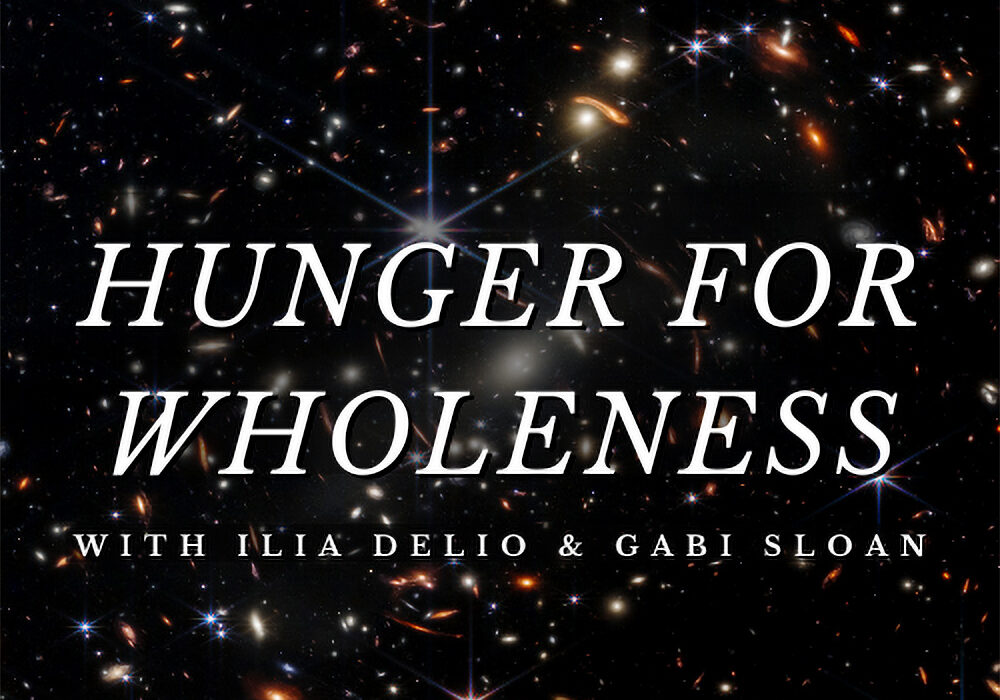Contemplation and Vision
Q: What is the relationship between contemplation and action, especially public acts of resistance?
 Ilia: This is an interesting question and one that I have reflected on over the years. Vatican II opened the windows of the Church to the complexities of history, and the universal call to holiness (Gaudium et spes). A renewed sense of Christian discipleship was kindled. At the same time, a theological renewal took place in which dogmatic theology was reinvigorated by a return to the original sources or wellsprings of foundational writings. Resourcement theology (“return to the sources”) brought with it a revival of the Christian mystical tradition and an awakening to the rich texts of mystical writers. My mentor at Fordham University, Ewert Cousins, played a key role in bringing original patristic and medieval mystical writings into the English-speaking world, in collaboration with Paulist Press. Ewert helped establish the Classics of Western Spirituality and thus opened the doors to the writings of the Early and Medieval mystical tradition.
Ilia: This is an interesting question and one that I have reflected on over the years. Vatican II opened the windows of the Church to the complexities of history, and the universal call to holiness (Gaudium et spes). A renewed sense of Christian discipleship was kindled. At the same time, a theological renewal took place in which dogmatic theology was reinvigorated by a return to the original sources or wellsprings of foundational writings. Resourcement theology (“return to the sources”) brought with it a revival of the Christian mystical tradition and an awakening to the rich texts of mystical writers. My mentor at Fordham University, Ewert Cousins, played a key role in bringing original patristic and medieval mystical writings into the English-speaking world, in collaboration with Paulist Press. Ewert helped establish the Classics of Western Spirituality and thus opened the doors to the writings of the Early and Medieval mystical tradition.
One of the advantages of reading the original sources was to see how terms like “contemplation” developed in Christianity. The word contemplation is not a Christian term but emerged in Greek philosophy. Plato understood the world of things to be imitations of true reality that lie beyond us in a world of ideal forms. The one who pursues truth must be freed from the senses that shackle the flesh and prevent us from seeing the real. Contemplation is training the mind to focus on divine things. Since the world of matter weighs us, one must withdraw from the world and turn inward where the divine light shines. The third century Neoplatonist, Plotinus, adopted the Platonic scheme and modified it, describing a metaphysical scheme whereby reality flows from the ultimate source of reality, the One, through the realms of the intellect and world Soul, down to the forms of created reality. To search for truth was to pursue a life of contemplation. Plotinus described the path of divinization as a flight of the alone to the Alone, a term adopted by Christian writers.
The first Christian systematic theologian, Origen of Alexandria, was a contemporary of Plotinus and like Plotinus saw contemplation as the highest activity of the human person. Contemplation was not a period of silent prayer followed by a burst of activity. Hence contemplation did not precede action or even give rise to action. In fact, distinguishing contemplation and action in the early Church would have been unthinkable. The fourth century monk, Evagrius, spoke of the active life as preparation for contemplation. The goal of the active life was to purify the passionate part of the soul through discipline and achieve the state of apatheia or passionlessness so as to rise in charity.[1] Gregory of Nyssa, one of the Cappadocian fathers, said that contemplation is the heart of Christian discipleship whereby one comes to see the brilliance of God in darkness and know God through the stripping away of all that is known.
For the early writers, there was no distinction between being and doing; rather being itself was a form of activity flowing from a deep centeredness in God. Contemplation was the highest activity of Christian life because it was ultimately the transformation of the mind in God. To consider placing a conjunction between “being and doing” or “contemplation and action” would have been unthinkable. Rather to live the Gospel life was to live a deep prayerful life rooted in the belief that Jesus did not come to change the world but to change the human person. The goal of the life was to acquire a new mind and a new heart and see the world in a new way. The contemplative was to see out of a new center and act out of a new energy of love. After all, if we want a different world, we must become a different people. In the early Church, the active life was preparation for the contemplative life, not the other way around.
Which brings me back to the question at hand, do civil acts of resistance relate to contemplation? And here I must be honest and say, not necessarily. While I do admire the public advocates of social justice who stand as the prophets and martyrs of our time, civil disobedience alone can do no other than act in resistance. Some actions may evoke political change but many actions simply raise a red flag that something is deeply amiss. Resistant action calls out to the public to become aware of the wrongdoing in our midst. It can raise the consciousness of the need to change but itself is not the change. It is not that we must contemplate in order to act; it is rather that action must lead to contemplation, and contemplation must lead to new vision, and new vision must lead to new structures of relationship.
One of the great mystics of our time who recently died, the Carthusian monk Fr. Bruno Barnhart, spoke of the sapiential wisdom of our age. In his book, The Future of Wisdom, Bruno suggested that our modern western world in in all of its sprawling untidiness is not a deviation from the path of Christ but its legitimate and inevitable trajectory.The upheavals and revolutions of modernity, the scientific revolution, secularity, global economics and computer age, he wrote, are not a betrayal of the spirit but a further creative expression of the dynamic Christic ground: “The history of the world in all of its messy, centrifugal energy is not a betrayal of the path of Christ but its lawful and inevitable trajectory.”[2] If God is deeply entwined with the world, then messy struggle is necessary for creative freedom in love to emerge. The contemplative is one who struggles through to a higher love and lives through the many deaths of the ego to attain freedom in Christ and creatively engage in a new reality.
Teilhard de Chardin spoke of religious experience as having evolutionary significance through centration of the universe. Contemplation maximizes consciousness, he said, building up a contemplative energetic which centrates, animates, and organizes the universe, increasing consciousness. An old woman praying alone in an out-of-the way chapel can move the universe, he claimed, by “entering directly into receptive communication with the very source of all interior drive.” In his view, God-Omega exerts its pull upon the universe through the human who, as the evolutionary spearhead of the universe, has the greatest capacity to be pulled. Only inner transformation can escape cosmic entropy and thus centrate energy on higher levels of complexity. Martin Laird wrote: “Through divinization the mystic becomes a doorway through which Christ-Omega enters and transforms the world in the Divine Milieu.”
I suppose what mystical writers then and now understand is that it is much more difficult to change oneself than it is to change the world. Resisting corrupt political regimes or standing in solidarity with the poor are noteworthy actions but the most radical action is to stand still before the crucified One, stripped of all ego, except the burning desire to love God. Beatrice Bruteau said it best: “An entire attitude, mind-set, way of identifying self and others and perceiving the world has to shift first, before any talk of economic, political, and social arrangements can be made. Anything else is premature, useless and possibly dangerous.” In the words of Thomas Merton, “the contemplative is one who acts by containing in oneself all divided worlds and transcending them in Christ.” Beatrice realized that “something will explode if we persist in trying to squeeze into our old tumble-down huts the material and spiritual forces that are henceforward on the scale of the world.”
To put this another way, contemplative prayer is not preparation for action nor is action the grist for contemplative prayer. Rather, contemplation must become the radicality of being itself so that one sees the world with new eyes. We participate in the act of creating when we ourselves open up to being created or re-created by the power of God’s love.
I certainly do not mean to refrain from public action but one who acts must also be able to see a new reality. One eye must look out to the world with its sorrows and tragedies and failures and one eye must look ahead to what does not yet exist, and the two eyes must work together as the third eye of the heart.
Action can lead to a fallacy of misplaced concreteness, as if action alone will actually change structures. The only thing that can change structures is the power of love. And the degree of love that changes the structures of relationships is an unthinkable love. To paraphrase Steve Jobs, it is the crazy ones who think they can change the world, the round pegs in the square holes, who actually do so because they see things differently. If you see what does not yet exist, and you act according to what you see, you will likely be seen as a little crazy, out of center, a misfit or rebel. But if you stay true to what you see because the power of God is the light of your vision, then you will change the world because you yourself will be changed. You will usher in a new reality by your own transformed being-in-love. This, I believe, is the heart of Christian discipleship.
In sum, contemplative vision is the heart of the Christian life by which one is brought into a new reality, connected through the heart to the whole of life, attuned to the deeper intelligence of nature, and called forth irresistibly by the Spirit to creatively express his or her gifts in the evolution of self and world.
Notes
[1] Louth, Christian Mystical Tradition, 103-09; John Eudes Bamberger, introduction to Evagrius Ponticus: The Praktikos, lxxxviii-xc; McGinn, Foundations of Christian Mysticism, 151-5
[2] Bruno Barnhart, The Future of Wisdom, 205.
 View print-friendly version
View print-friendly version
2 Comments
Related Posts

Hunger for Wholeness Podcast Launches!
Story matters. Our lives are shaped around immersive, powerful stories that thrive at the heart of our religious traditions, scientific inquiries, and cultural landscapes. All stories – big and small…


Very helpful, thank you. I’m aware of Father Bruno’s book and will follow up your reference to it. Could you give me a reference to the source of your quote from Beatrice Bruteau, please.
Like all your stuff I’ll have to reread a number of times. Learning a lot. Thank you.